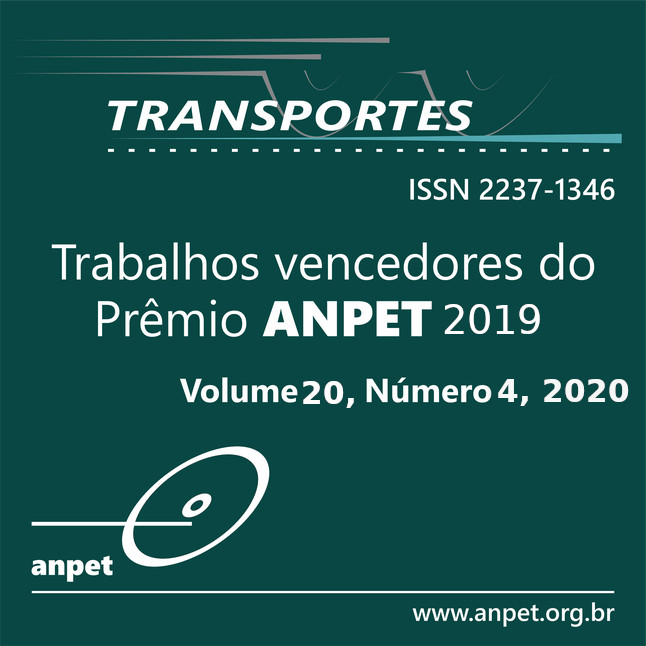Modelling the operations of a hinterland container terminal to maximize the contribution margin
DOI:
https://doi.org/10.14295/transportes.v28i4.2019Keywords:
Hinterland terminal. Containers. Contribution margin.Abstract
The facilities specialized in container management, also known as hinterland terminals, have emerged to facilitate the competitiveness of the container ports in the global market. This paper proposes an integer linear mathematical programming model to determine the optimal number of operations of a hinterland terminal that maximizes its profit from the perspective of maximum financial return. The model considers different operations in specific areas of a terminal and multiple products in different categories of containers over a planning horizon. Different scenarios were specified in the context of a hinterland terminal in Itapoá-SC. The maximum profit occurs by separating the commodity wood into lumber and plywood, the most profitable one. The second scenario of highest profit refers to adding a shift to the maintenance sector of the hinterland terminal.
Downloads
References
Bandeira, D. L. (2005) Alocação e movimentação de contêineres vazios e cheios: um modelo integrado e sua aplicação. Tese de Doutorado, Universidade Federal do Rio Grande do Sul.
Bontekoning, Y. M.; C. Macharis e J. J. Trip (2004) Is a new applied transportation research field emerging? A review of in-termodal rail–truck freight transport literature. Transportation Research Part A: Policy and Practice, v. 38, n.1, p. 1–34. DOI: 10.1016/j.tra.2003.06.001.
Braekers, K.; A. Caris e G. K. Janssens (2014) Bi-objective optimization of drayage operations in the service area of intermod-al terminals. Transportation Research Part E: Logistics and Transportation, v. 65, p. 50–69. DOI: 10.1016/j.tre.2013.12.012.
Caris, A. e G. K. Janssens (2009) A local search heuristic for the pre-and end-haulage of intermodal container terminals. Computers & Operations Research, v. 36, n. 10, p. 2763–2772. DOI: 10.1016/j.cor.2008.12.007.
Chou, C. -C.; R. -H. Gou; C. -L. Tsai; M. -C. Tsou; C. -P. Wong e H. -L. Yu (2010) Application of a mixed fuzzy decision making and optimization programming model to the empty container allocation. Applied Soft Computing, v. 10, n. 4, p. 1071–1079. DOI: 10.1016/j.asoc.2010.05.008.
Costa, G. A. A. (2006) Modelo de margem de contribuição aplicado ao planejamento de marketing no transporte marítimo regular de contêineres. Dissertação de Mestrado, Universidade de São Paulo. DOI: 10.11606/D.3.2006.tde-18092006-174148.
Dong, J.-X. e D. -P. Song (2009) Container fleet sizing and empty repositioning in liner shipping systems. Transportation Research Part E: Logistics and Transportation, v. 45, n. 6, p. 860–877. DOI: 10.1016/j.tre.2009.05.001.
Funke, J. e H. Kopfer (2015). A neighborhood search for a multi-size container transportation problem. IFAC-PapersOnLine, v. 48, n. 3, p. 2041–2046. DOI: 10.1016/j.ifacol.2015.06.389.
Guo, X.; S. Y. Huang; W. J. Hsu e M. Y. H. Low (2011) Dynamic yard crane dispatching in container terminals with predicted vehicle arrival information. Advanced Engineering Informatics, v. 25, n. 3, p. 472–484. DOI: 10.1016/j.aei.2011.02.002.
Jeevan, J.; N. Salleh; K. Loke e A. Saharuddin (2017) Preparation of dry ports for a competitive environment in the container seaport system: A process benchmarking approach. International Journal of e-Navigation and Maritime Economy v. 7, n. 3, p. 19–33. DOI: 10.1016/j.enavi.2017.06.003.
Kaveshgar, N. e N. Huynh (2015) Integrated quay crane and yard truck scheduling for unloading inbound containers. Inter-national Journal of Production Economics, v. 159, p. 168–177. DOI 10.1016/j.ijpe.2014.09.028.
Laptaned, U. (2007). Developing Inland Container Depot for the Indo-China Intersection Logistics Center: Case Study of Phitsanulok Province. In 2nd International Conference on Operations and Supply Chain Management, p. 389–396.
Lee, C.-Y. e Q. Meng (2015) Handbook of Ocean Container Transport Logistics: Making Global Supply Chains Effective, v. 220. Springer, Nova Iorque. DOI: 10.1007/978-3-319-11891-8.
Myung, Y.-S. e E. I. Moon (2014) A network flow model for the optimal allocation of both foldable and standard containers. Operations Research Letters, v. 42, n. 6, p. 484–488. DOI: 10.1016/j.orl.2014.08.004.
Shiri, S. e N. Huynh (2016) Optimization of drayage operations with time-window constraints. International Journal of Pro-duction Economics, v. 176, p. 7–20. DOI: 10.1016/j.ijpe.2016.03.005.
Song, D.-P. e J. -X. Dong (2012) Cargo routing and empty container repositioning in multiple shipping service routes. Trans-portation Research Part B: Methodological, v. 46, n. 10, p. 1556–1575. DOI: 10.1016/j.trb.2012.08.003.
Sterzik, S. e H. Kopfer (2013) A tabu search heuristic for the inland container transportation problem. Computers & Opera-tions Research, v. 40, n. 4, p. 953–962. DOI: 10.1016/j.cor.2012.11.015.
Teixeira, R. B. e C. B. Cunha (2012) Modelo integrado de seleção de cargas e reposicionamento de contêineres vazios no transporte marítimo. TRANSPORTES, v. 20, n.1, p. 59–70. DOI: 10.4237/transportes.v20i1.442.
Zain, R. M.; M. N. A. Rahman; N. Saibani; Z. M. Nopiah; A. Ramili e N. Jusoh (2015) Exploring the delays at empty container off-dock depots: useful perceptions by stakeholders. Management, v. 5, n. 5, p. 148-159. DOI: https://doi.org/10.5923/j.mm.20150505.02.
Zhang, R.; W. Y. Yun e I. Moon (2009) A reactive tabu search algorithm for the multi-depot container truck transportation problem. Transportation Research Part E: Logistics and Transportation Review, v. 45, n. 6, p. 904– 914. DOI: 10.1016/j.tre.2009.04.012.
Downloads
Published
How to Cite
Issue
Section
License
Authors who submit papers for publication by TRANSPORTES agree to the following terms:
- The authors retain the copyright and grant Transportes the right of first publication of the manuscript, without any financial charge, and waive any other remuneration for its publication by ANPET.
- Upon publication by Transportes, the manuscript is automatically licensed under the Creative Commons License CC BY 4.0 license. This license permits the work to be shared with proper attribution to the authors and its original publication in this journal, and to be adapted for non-commercial purposes, provided appropriate credit is given and any derivative works are distributed under the same terms.
- Authors are authorized to enter into additional separate contracts for the non-exclusive distribution of the version of the manuscript published in this journal (e.g., publishing in an institutional repository or as a book chapter), with recognition of the initial publication in this journal, provided that such a contract does not imply an endorsement of the content of the manuscript or the new medium by ANPET.
- Authors are permitted and encouraged to publish and distribute their work online (e.g., in institutional repositories or on their personal websites) after the editorial process is complete. As Transportes provides open access to all published issues, authors are encouraged to use links to the DOI of their article in these cases.
- Authors guarantee that they have obtained the necessary authorization from their employers for the transfer of rights under this agreement, if these employers hold any copyright over the manuscript. Additionally, authors assume all responsibility for any copyright infringements by these employers, releasing ANPET and Transportes from any responsibility in this regard.
- Authors assume full responsibility for the content of the manuscript, including the necessary and appropriate authorizations for the disclosure of collected data and obtained results, releasing ANPET and Transportes from any responsibility in this regard.









